Introduction
Background of the Study
Curriculum Vitae or CV, is a Latin phrase created since early 20th century with the meaning “the course of life”. According to Oxford Dictionary (2011), it is defined as “a brief account of a person education, qualifications, and previous occupations, typically sent with a job application”. Thus, a CV reflects graduates’ academic credentials, social and leadership qualities besides the experience and knowledge they gain in the previous careers. In the 1980’s, job applications require graduates to write a printed CV to be sent to the employers (Middleton, 2007).
Universiti Teknologi MARA (UiTM), Penang campus, Malaysia had organized a CV writing seminar for diploma students in semester five who are required to attend a ‘Career Talk’ seminar in order to guide them with the job interview and also CV writing. Besides, it is offered to help students to plan their career path, develop their self-confidence and motivate their interest for a specific career ambition. According to Aida Mauziah et al (2005), career centre enables students to strategize their plans and polish their job-related soft skills towards making the career ambition a reality. Thus, with career awareness, students would show great effort to impress the future employers to excel either in the CV writing or job interview. Perhaps, with the advancement of the Internet and Web technologies, students can use Web-enabled technologies to prepare and display their CV more creatively. During the seminar, a concept of m-CV was purposely designed and proposed to the students. The researchers of this paper believe that m-CV is cost saving and is an alternative to present oneself in live manner. Thus, it is important to consider the potential of m-CV and the students’ perception towards m-CV in applying a job.
Problem Statement
Unemployment problem has become a critical issue in today’s Malaysian society (Abd.Rahim et al, 2005; Mohammad et al, 2007). It is obvious that the job market is looking for high quality graduates who possess not only academic credentials but also those who are competitive and creative. CV is recommended to be submitted for an academic position or a grant application. In this e-generation, mobile phones and Internet are ubiquitous; thus, publishing CV through mobile devices anytime and anywhere is time and cost saving. Preparing a CV for a job interview could be balking and frustrating to some graduates.
According to Holmes (2003), a traditional CV fails to highlight the candidates’ strength, skills and achievement effectively. Thus, graduates are unable to sell and present themselves in an interactive way in order to impress the employer. Shukran and Saodah (2005) on the other hand, claimed that besides self motivation, CV writing skills is also important to market graduates to prospective employers. Unfortunately, traditional CV provides a dull list of achievement and personal details which do not fit the modern patterns of employment and career change (Holmes, 2003). As a result, this hinders graduates’ talent and creativity to ‘sell’ and ‘publicize’ their strength.
Besides, lack of channel to inform the workplace requirements (Shukran & Saodah, 2005) also demotivates graduates in the job employment. Hence, shifting to mobile CV could be an effective way to motivate and advertise graduates’ credibility online to increase the chances in getting their dream job.
Objectives of the Study
The objectives of the study are:
- Identifying the perceived ease of use of m-CV among university students;
- Identifying the perceived usefulness of m-CV among university students;
- Identifying the behavioral intention of using m-CV among university students.
Significance of the Study
Although the traditional CV is still being practiced until today, the self-marketing strategy is now shifting gears. This is due to the revolution of information and technology that has encouraged the value of ICT applications in our everyday lives (Mohammad et al, 2007). Besides, personal computers or laptops which now replace type-writers are mostly available at home to make CV editing and CV preparation more flexible. Since a well-prepared CV enhances the chances of graduates in getting an interview (Hesse, 2006; Middleton, 2007), this highlights the significant touch of IT towards generations.
This study is making university students aware of the use and potential of m-CV in applying a job. However, in our knowledge, there has not been any current research to explore the acceptance of the society and students towards using m-CV tools. Besides, this study can rise up the awareness among the educators about the university students’ perception towards m-CV in applying a job.
Literature Review
Literature Review
Curriculum Vitae
Writing a Curriculum Vitae or CV is definitely important for graduates to be invited to an interview. With the high competition of today’s job market, it is vital to impress the future employers by preparing a CV that distinguishes itself from others (Hesse, 2006; Middleton, 2007). There is a previous research that has been carried out to explore the significance of a CV to job applicants. Steinpreis et al (1999) studied the factors that influence outside reviewers and search committee when they are reviewing CV with respect to the applicants’ gender. The result shows that both men and women are likely to vote to hire a male job applicant than an equally potential female job applicant. Hence, this research concludes that there is a gender bias for both men and women in favor of the male job applicants.
Fishcher (2001) in his study stated that a traditional CV is unable to present one’s contribution effectively. This is due to the narrow focus of vitae in providing professional information about an individual. Thus, he proposed a professional portfolio in practice since a professional portfolio provides a broader representation of total achievements, grants, society memberships and also document skills and evidence of collaboration. Fishcher (2001) claimed that a portfolio would not replace the vitae but would summarize one’s achievement in a way it could be updated frequently and valued by professionals and colleagues.
Mobile Curriculum Vitae
For the purpose of this study, the proposed m-CV is created and can be accessed online freely (http://m-curriculumvitae.blogspot.com). It has been firstly presented to a group of UiTM Penang students during a Career Talk seminar held in 19th March 2011. Basically, it is an online CV presentation using weblog as the developing platform that comes with both web and mobile versions. Figure 1 shows the screen shot of mobile Curriculum Vitae in Web view format while Figure 2 depicts the screen shot of m-CV in mobile view format.
Besides, by publishing the CV online, graduates can print or view the CV via Internet using various mobile devices such as cell phone, netbook and notebook. Thus, with career awareness, students would show great effort to impress the future employers to excel either in the CV writing or job interview. Since m-CV is cost saving and it is an alternative to present oneself in live manner, it is utmost valuable to develop an individual m-CV as an important document in applying a desirable job.
More importantly, it is eco-friendly since the use of m-CV advocates the “Green Campaign”–no paper and inks are used. Writing, editing and viewing the CV directly through handheld devices anytime and anywhere are time and cost saving. Moreover, relevant videos, pictures and audio files can be uploaded to present oneself in a more interactive and lively manner. This can be one of the most effective ways to “publicize” and “sell” oneself due to today’s highly competitive job market. It may also increase the chance of getting the dream job, motivate oneself, and impress the future employer.
In the global era, graduates face new challenges and competition in getting their dream careers. In fact, a CV in this digital age is no longer a statement of career experience to date, but a marketing document (Holmes, 2003; Hesse, 2006; Middleton, 2007). Boyle (2010) is of the view that building a network helps graduates to promote themselves to potential employers and companies. This is due to the informal networking that can take place anywhere with anybody – family, friends and even people online. Thus, the m-CV can be an alternative since it allows graduates to publish a CV online in which it can be viewed by potential employers or recruiters who are looking for candidates (Holmes, 2003).
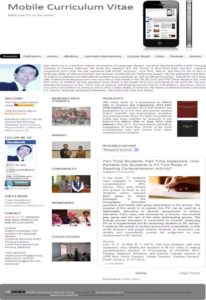
Fig 1. Screen Shot of Mobile Curriculum Vitae or M-CV
(http://m-curriculumvitae.blogspot. com) in Web version.
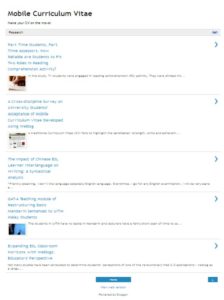
Fig 2. Screen Shot of Mobile Curriculum Vitae or M-CV
(http://m-curriculumvitae.blogspot. com/?m=1) in mobile version.
Technology Acceptance Model (TAM)
As indicated in the literature review, Technology Acceptance Model (TAM) has been identified as one of the most established models on technology acceptance. TAM was originally proposed by Fred Davis in 1989 as one of the most influential extensions of Ajzen and Fishbein’s Theory of Reasoned Action. TAM developed by Fred Davis and Richard Bagozzi models how users come to accept and use a technology. According to Landry et al. (2006, p. 89), TAM can be interpreted as “ones behavior and the intent to behave is a function of one’s attitude toward the behavior and their perceptions about the behavior”. The model proposes that when users are presented with a new system, technology, or software package, a number of factors affect their decision about how and when they will use it. TRA and TAM, both of which have strong behavioral elements, assume that when someone forms an intention to act, they will be free to act without limitation. The research model used in the study is shown in Figure 3.
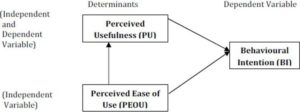
Fig 3. Conceptual Framework Pertaining the Acceptance of M-CV
The goal of this model is to provide an explanation of the determinants of technology acceptance. The intention of this study is to investigate university student’s acceptance of m-CV, therefore to develop an understanding of students’ acceptance of m-CV among Malaysian students by applying the TAM would be appropriate. In this study, only three variables of TAM were used to understand the students’ acceptance of m-CV. The three variables are ease of use, usefulness, and behavioral intention to use mobile CV. Ease of Use is defined as the degree to which a student perceives that use of m-CV to be free of effort. Usefulness is defined as the probability that a student finds m-CV valuable to their future. Lastly, we defined Behavioral Intention to Use as a student’s willingness to use m-CV tool.
Research Methodology
This research deployed a survey method to investigate students’ perception towards Mobile Curriculum Vitae (http://m-curriculumvitae.blogspot.com). A 23-item questionnaire-Mobile Curriculum Vitae (http://m-curriculumvitae.blogspot.com) Acceptance Questionnaire adapted from TAM model was designed for the purpose of this study. The questionnaires were distributed after conducting a seminar on Mobile Curriculum Vitae (http://m-curriculumvitae.blogspot.com). The 15 items measured respondents’ acceptance of m-CV, which cover three major variables: Perceived Usefulness (PU), Perceived Ease of Use (PEOU) and Behavioral Intention (BI) to use it. Four-point Likert scale was applied in the questionnaire (1=strongly disagree, 2=disagree, 3=agree, and 4=strongly agree). Besides, questions pertaining to the students’ demographic information such as gender, age, and program were also included. A total of 191 questionnaires were collected and SPSS v.15 was employed for administering descriptive analysis.
Findings and Discussion
From the total number of questionnaires distributed, 191 were completed and returned, showing a 98% response rate. The general demographics of the participants for gender showed that 90 participants were female (47.6%) and 99 participants were male (52.4%), and 2 participants didn’t indicate their gender in the survey form. The mean age of the participants was 21.5 years old. The majority of these students (98%) are studying in semester 5 and above and they are doing diploma courses at UiTM Penang. These targeted students are going to graduate in next year. The researchers expect them to already have the knowledge of writing a CV. This study is a cross-discipline investigation of students’ acceptance of m-CV. Figure 4 provides the distribution of students attending different study program at UiTM Penang. Table 1 and Figure 5 depict the findings on students’ perception towards the ease of use of m-CV. Five items as listed in Table 1 have been evaluated.
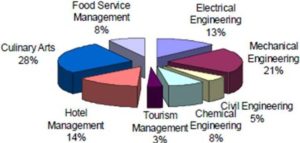
Fig 4. The Distribution of Students According to Study Program
Table 1: Perceptions of Ease Of Use of M-CV
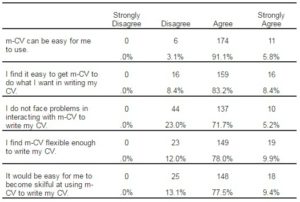
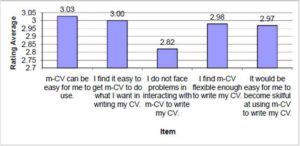
Fig 5. Average Rating on Each Item Related to Perceptions of Ease of Use of M-CV
The students generally confirmed that m-CV was easy to use. Over 90% of the students agreed or strongly agreed that it can be easy for him/her to use it and do what he/she wants to write in their CV with this technology. Nearly 80% students agreed and strongly agreed that they do not face any problems interacting with m-CV if they want to write their CV. More than 85% agreed and strongly agreed that they would easily become skilful at using mobile CV. Looking at the mean however, we see that in all cases the mean lies between 2.8 and 3, which is more to the middle of the scale spectrum. Table 2 and Figure 6 show the findings on students’ perception towards the usefulness of m-CV. Five items as listed in Table 2 have been evaluated.
Table 2: Perceptions of Usefulness of M-CV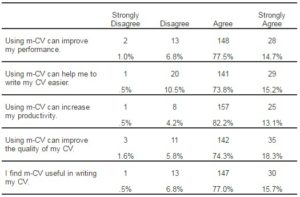
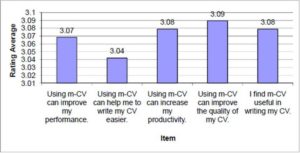
Fig 6. Average Rating on Each Item Related to Perceptions of Usefulness of M-CV
The usefulness of m-CV was also confirmed, although the findings were not as strong as they were with the ease of use construct. 92.2% of the students agreed or strongly agreed that using m-CV can improve their performance. 85% of the students agreed or strongly agreed that the m-CV can help them to write a CV easier. Approximately, over 95% of the students agreed or strongly agreed that using m-CV can increase their productivity and also improve the quality of their CV. However, it was found that more than 92% of the students agreed or strongly agreed that m-CV is useful in writing CV. Looking at the mean however, we see that in all cases the mean lies over the value 3. Table 3 and Figure 7 reveal the findings on students’ perception towards the behavioral intention to use m-CV. Five items as listed in Table 3 have been evaluated.
Table 3: Behavioural Intention to Use M-CV
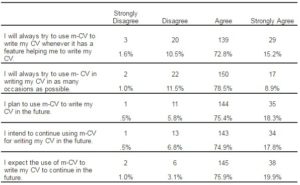
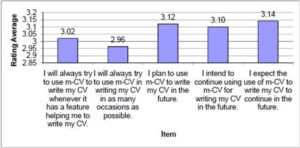
Fig 7. Average Rating on Each Item Related to Intention to Use M-CV
The students also displayed their intention to use m-CV, as nearly 88% of the students agreed or strongly agreed that they will always try to use it to write CV if this technology provides a help feature to guide them towards writing a CV. On the other hand, 87.5% of the students agreed or strongly agreed that they will always use it in writing CV in as many occasions as possible. In this study, it was found that over than 90% of the students agreed or strongly agreed that they plan to use m-CV to write their CV in the future and intend to continue using m-CV for writing their CV in future. Nearly 96% of the students agreed or strongly agreed that they have the expectation that they will use mobile CV to write their CV to continue in the future. Looking at the mean however, we see that in all cases the mean lies between 2.96 and 3.14 which is more to the middle of the scale spectrum. Table 4 provides the means and standard deviations of the survey items measuring perceived ease of use, perceived usefulness, and behavioral intention to use m-CV. Figure 8 shows the overall average rating for perceived ease of use, perceived usefulness and behavioral intention to use m-CV.
Table 4: Overall Average Rating and Standard Deviations for Perceived Ease of Use, Perceived Usefulness and Behavioral Intention to Use M-CV

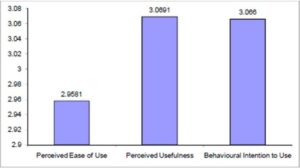
Fig 8. Overall Average Rating For Perceived Ease of Use, Perceived Usefulness and Behavioural Intention to Use of M-CV
Conclusion
Based on the respondents’ responses in the study, m-CV was perceived to be more useful rather than easy to use, which enables the researchers to elucidate the reasons behind the acceptance of m-CV as the next generation of CV presentation. Based on the results, the study strongly proposed the practice of m-CV as a means of CV writing. m-CV is not only a website similar to a personal journal or diary designed to be updated with items in a linear and time-based fashion, but also the contents are meant specifically for public consumption. Moreover, the study notably found that students’ perceived usefulness may have direct effects on their intention to adopt m-CV. It showed that students’ perceived ease of use might be mediated by their perceived usefulness, which had considerable indirect effects on their intention to use m-CV. An understanding of users’ acceptance on m-CV can assist to develop better approaches for designing, evaluating, and predicting the manner in which users will react to new presentation of CV. The study further discovered that the behavioral intention influenced by perceived ease of use and perceived usefulness closely relied on user’s exposure through attending the seminar. This entailed that introducing a new technology to students with training will have more significant effect on their perceived ease of use, perceived usefulness, and behavioral intention to use the technology.
(adsbygoogle = window.adsbygoogle || []).push({});
References
Abd. Rashid, A., Hussin, S. & Putih, A. T. (eds.) (2005). Career Development and Unemployment in Problems in Malaysia, Utusan Publications & Distributors, Kuala Lumpur.
Publisher
Abdul Rahman, S. & Wok, S. (2006). “The Role of Career Services Centre,” Career Development and Unemployment in Problems in Malaysia,” Utusan Publications & Distributors, Kuala Lumpur.
Publisher – Google Scholar
Benjamin, A. M., Ahmad, N. & Lang, A. C.. (2005). ‘Career decision making: A study of sub-urban secondary school students, Career Development And Unemployment in Problems in Malaysia,’ Abd. Rahim Abd. Rashid, Sufean Hussin and Abu Talib Putih. (eds.). Utusan Publications & Distributors, Kuala Lumpur.
Boyles, C. (2010). ‘Career Management Secrets,’ Harper Collins Publisher, Great Britain.
Fischer, J. R. (2001). “The Professional Portfolio: Beyond the Curriculum Vitae,” Issue Paper. 18. [Online], [Retrieved March 28, 2011], http://www.castscience.org/websiteUploads/publicationPDFs/ portfolio.pdf
Publisher – Google Scholar
Hesse, P. M. (2006). ‘Career Excellence,’ Thompson Delmar Learning, Canada
Holmes, S. (2003). ‘CV Types and Styles,’ [Online], [Retrieved March 15, 2011], http://www.jobseekersadvice.com/cv_advice/articles/why_are_you_moving.htm
Landry, B. J. L., Griffeth, R. & Hartman, S. (2006). “Measuring Student Perceptions of Blackboard Using the Technology Acceptance Model,” Decision Science Journal of Innovative Education 4 (1). 87–99.
Publisher – Google Scholar – British Library Direct
Middleton, J. (2007). High Impact CVs, Careers, Finance & Personal Development, United Kingdom.
Mohammad Haji Alias, Zurina Kefeli@Zulkefli & Nursilah Ahmad. (2007). Employability of Islamic Studies Graduates in Malaysia, Universiti Sains Islam Malaysia, Negeri Sembilan.
Oxford Dictionaries. (2010). ‘Curriculum Vitae,’ Oxford University Press. [Online], [Retrieved March 28, 2011], http://oxforddictionaries.com/definition/ curriculum+vitae.
Steinpreis, R. E., Anders, K. A. & Ritzke, D. (1999). “The Impact of Gender on the Review of the Curricula Vitae of Job Applicants and Tenure Candidates: A National Empirical Study,” Sex Roles 41 (7) [Online], [Retrieved March, 28 2011], http://www.faculty.diversity.ucla.edu/search/searchtoolkit/docs/articles/Impact_of_Gender.pdf
Publisher – Google Scholar – British Library Direct














